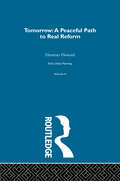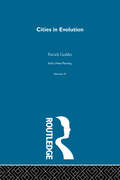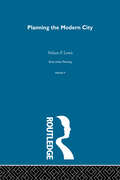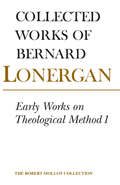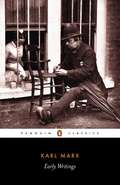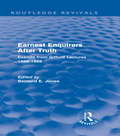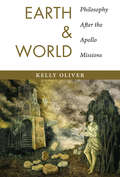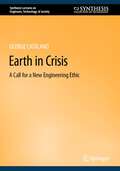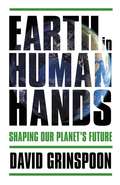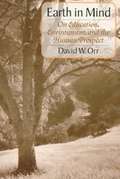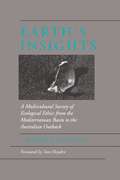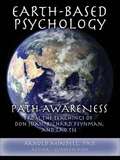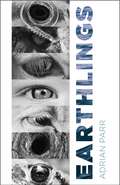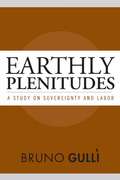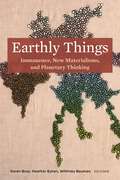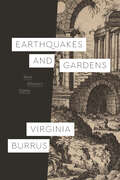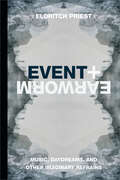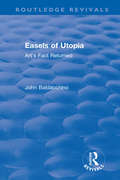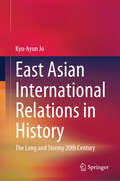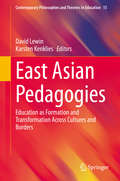- Table View
- List View
Early Urban Planning V2
by Ebenezer HowardFirst published in 2004. This collection brings together five volumes of classic texts of early modern urban planning. These writings stem from the late nineteenth century up to World War II and permits the reader to evaluate the history of urban planning as one of the great characteristics of modernism and lays the groundwork for speculation about the future of urban planning in the fast-emerging new world. Volume 2 includes ‘Tomorrow: A Peaceful Path to Real Reform.
Early Urban Planning V4: An Introduction To The Town Planning Movement And To The Study Of Civics (classic Reprint)
by Patrick GeddesFirst published in 2004. This collection brings together five volumes of classic texts of early modern urban planning. These writings stem from the late nineteenth century up to World War II and permits the reader to evaluate the history of urban planning as one of the great characteristics of modernism and lays the groundwork for speculation about the future of urban planning in the fast-emerging new world. Volume 4 includes Cities in Evolution: An introduction to the Town Planning Movement and to the Study of Civics.
Early Urban Planning V5: A Review Of The Principles Governing City Planning (classic Reprint)
by Nelson P. LewisFirst published in 2004. This collection brings together five volumes of classic texts of early modern urban planning. These writings stem from the late nineteenth century up to World War II and permits the reader to evaluate the history of urban planning as one of the great characteristics of modernism and lays the groundwork for speculation about the future of urban planning in the fast-emerging new world. Volume 5 includes Planning the Modern City: A Review of the Principles Governing City Planning.
Early Works on Theological Method 1: Volume 22
by Bernard Lonergan Robert Doran, S.J. Robert CrokenThe renowned Christian theologian Bernard Lonergan was also a professor, teaching courses on theological method at universities in Canada, the United States, and Italy. This volume records his lectures and teaching materials, thus preserving and elucidating his intellectual development between the publication of Insight in 1957 and Method in Theology in 1972.The present volume contains a record of the lectures delivered in 1962 (Regis College, Toronto), 1964 (Georgetown University), and 1968 (Boston College). This is the most 'interactive' volume yet published in the Collected Works series. The audio recordings of the 1962 and 1968 lectures are now available on the website www.bernardlonergan.com, as are PDF files of original papers from his 1964 institute at Georgetown. These lectures help to elucidate the development of Lonergan's ideas on such key notions as horizon, conversion, and meaning, as well as his evolving opinion on how best to divide theology into fields of specialization.
Early Writings
by Karl MarxWritten in 1833-4, when Marx was barely twenty-five, this astonishingly rich body of works formed the cornerstone for his later political philosophy. In the Critique of Hegel's Doctrine of the State, he dissects Hegel's thought and develops his own views on civil society, while his Letters reveal a furious intellect struggling to develop the egalitarian theory of state. Equally challenging are his controversial essay On the Jewish Question and the Economic and Philosophical Manuscripts, where Marx first made clear his views on alienation, the state, democracy and human nature. Brilliantly insightful, Marx's Early Writings reveal a mind on the brink of one of the most revolutionary ideas in human history - the theory of Communism.This translation fully conveys the vigour of the original works. The introduction, by Lucio Colletti, considers the beliefs of the young Marx and explores these writings in the light of the later development of Marxism.
Earnest Enquirers After Truth: A Gifford Anthology: excerpts from Gifford Lectures 1888-1968 (Routledge Revivals)
by Bernard E JonesFirst published in 1970, Bernard E. Jones’s selection of Gifford lectures includes excerpts from the writings of over ninety scholars who occupied a Gifford Chair between 1888 and 1968. Lord Gifford had asked his lecturers to be ‘honest to God’, insisting that they should be ‘earnest enquirers after truth’ and had always envisaged the lectures being published. Dr Jones’s anthology is arranged under headings suggested by phrases from Lord Gifford’s will. The selection, which includes names such as William James, A.N. Whitehead, Temple, Barth, Brunner, Bultmann, Niebuhr and Tillich, was made in such a way that the reader would be able to really grasp what natural theology is about. Bernard Ewart Jones served as a Methodist minister, before being appointed to the Lewins Chair of Philosophy at his old college, Hartley Victoria, Manchester. He was awarded a doctorate by the University of Leeds in 1966 for his thesis on ‘The Concept of Natural Theology in Gifford Lectures’.
Earth and World
by Kelly OliverCritically engaging the work of Immanuel Kant, Hannah Arendt, Martin Heidegger, and Jacques Derrida together with her own observations on contemporary politics, environmental degradation, and the pursuit of a just and sustainable world, Kelly Oliver lays the groundwork for a politics and ethics that embraces otherness without exploiting difference. Rooted firmly in human beings' relationship to the planet and to each other, Oliver shows peace is possible only if we maintain our ties to earth and world.Oliver begins with Immanuel Kant and his vision of politics grounded on earth as a finite surface shared by humans. She then incorporates Hannah Arendt's belief in plural worlds constituted through human relationships; Martin Heidegger's warning that alienation from the Earth endangers not only politics but also the very essence of being human; and Jacques Derrida's meditations on the singular worlds individuals, human and otherwise, create and how they inform the reality we inhabit. Each of these theorists, Oliver argues, resists the easy idealism of world citizenship and globalism, yet they all think about the earth against the globe to advance a grounded ethics. They contribute to a philosophy that avoids globalization's totalizing and homogenizing impulses and instead help build a framework for living within and among the world's rich biodiversity.
Earth and World: Philosophy After the Apollo Missions
by Kelly OliverCritically engaging the work of Immanuel Kant, Hannah Arendt, Martin Heidegger, and Jacques Derrida together with her own observations on contemporary politics, environmental degradation, and the pursuit of a just and sustainable world, Kelly Oliver lays the groundwork for a politics and ethics that embraces otherness without exploiting difference. Rooted firmly in human beings' relationship to the planet and to each other, Oliver shows peace is possible only if we maintain our ties to earth and world.Oliver begins with Immanuel Kant and his vision of politics grounded on earth as a finite surface shared by humans. She then incorporates Hannah Arendt's belief in plural worlds constituted through human relationships; Martin Heidegger's warning that alienation from the Earth endangers not only politics but also the very essence of being human; and Jacques Derrida's meditations on the singular worlds individuals, human and otherwise, create and how they inform the reality we inhabit. Each of these theorists, Oliver argues, resists the easy idealism of world citizenship and globalism, yet they all think about the earth against the globe to advance a grounded ethics. They contribute to a philosophy that avoids globalization's totalizing and homogenizing impulses and instead help build a framework for living within and among the world's rich biodiversity.
Earth in Crisis: A Call for a New Engineering Ethic (Synthesis Lectures on Engineers, Technology, & Society #26)
by George CatalanoThis book examines the ethical responsibilities of engineers and scientists in light of new advances in science with a distinct reflection on quantum mechanics. This thorough coverage of these new advances will assist the reader in rethinking our place in the universe and broadening a sense of ethical responsibility for the planet. This book addresses an approach to integrating these changes and deal with issues such as global climate change and the sixth extinction. This book compares new ideas in engineering that extend ethical boundaries beyond our present understanding in which Engineering ethics is locked in the world view of the 18th and 19th centuries. This books coverage examines how our understanding of the world has changed due to developments in science and society to include green, humanitarian, social justice, and omnium approaches to the engineering profession. The coverage of societal and ethics in science and engineering practice are examined through four major areas. Green engineering is the design that promotes the use of processes and products that minimize pollution, promote sustainability, and protect human health without sacrificing economic viability and efficiency. Humanitarian engineering seeks to directly improve the well-being of poor, marginalized, or under-served communities, which often lack the means to address pressing problems. Engineering for social justice imagines a new kind of engineering firmly affixed to the common good. Finally, a new approach, omnium engineering, seeks to promote an engineering profession that considers the wants and needs of all life forms not only that of the human speciesThe scope of this treatise is to examine the premise that the earth is facing grave crises when confronting global climate change and the sixth extinction. Engineering may be the planet’s last best hope, but it requires a new ethic that takes a much broader view of the profession’s ethical responsibilities. Moreover, the engineering ethic is rooted in the science of the past (Newtonian mechanic). Science has changed (quantum mechanics) but the engineering world view has not. Embracing this new science will inevitably lead to a new story of our responsibilities towards the planet.
Earth in Human Hands: Shaping Our Planet's Future
by David GrinspoonFor the first time in Earth's history, our planet is experiencing a confluence of rapidly accelerating changes prompted by one species: humans. Climate change is only the most visible of the modifications we've made--up until this point, inadvertently--to the planet. And our current behavior threatens not only our own future but that of countless other creatures. By comparing Earth's story to those of other planets, astrobiologist David Grinspoon shows what a strange and novel development it is for a species to evolve to build machines, and ultimately, global societies with world-shaping influence. Without minimizing the challenges of the next century, Grinspoon suggests that our present moment is not only one of peril, but also great potential, especially when viewed from a 10,000-year perspective. Our species has surmounted the threat of extinction before, thanks to our innate ingenuity and ability to adapt, and there's every reason to believe we can do so again. Our challenge now is to awaken to our role as a force of planetary change, and to grow into this task. We must become graceful planetary engineers, conscious shapers of our environment and caretakers of Earth's biosphere. This is a perspective that begs us to ask not just what future do we want to avoid, but what do we seek to build? What kind of world do we want? Are humans the worst thing or the best thing to ever happen to our planet? Today we stand at a pivotal juncture, and the answer will depend on the choices we make.
Earth in Mind: On Education, Environment, and the Human Prospect
by David W. OrrOrr (environmental studies and politics, Oberlin College) presents the tenth anniversary edition of his text addressing educational reform from an environmental perspective. In a collection of 23 essays, written for various purposes and audiences between 1990 and 1993, Orr argues that, where educational debates about standards and reforms have centered around preparing students to compete in a global economy, an equally important concern should be teaching students the ecological context in which humans live, to develop in them an ethical view of the world and their obligations to it. The tenth edition includes a brief new introduction and a new final chapter offering "hope in hard times. " Annotation ©2004 Book News, Inc. , Portland, OR (booknews. com)
Earth's Insights
by J. Baird CallicottThe environmental crisis is global in scope, yet contemporary environmental ethics is centered predominantly in Western philosophy and religion. Earth's Insights widens the scope of environmental ethics to include the ecological teachings embedded in non-Western worldviews. J. Baird Callicott ranges broadly, exploring the sacred texts of Islam, Hinduism, Jainism, Taoism, Confucianism, and Zen Buddhism, as well as the oral traditions of Polynesia, North and South America, and Australia. He also documents the attempts of various peoples to put their environmental ethics into practice. Finally, he wrestles with a question of vital importance to all people sharing the fate of this small planet: How can the world's many and diverse environmental philosophies be brought together in a complementary and consistent whole?
Earth's Insights: A Multicultural Survey of Ecological Ethics from the Mediterranean Basin to the Australian Outback
by J. Baird CallicottAlthough environmental crisis is global in scope, contemporary environmental ethics is centered predominantly in Western philosophy and religion. EARTH'S INSIGHTS widens the scope to include the ecological teachings embedded in non-Western world views. Conservationist J. Baird Callicott asks how the world's diverse environmental philosophies can be brought together to benefit the whole.
Earth, Ice, Bone, Blood: Permafrost and Extinction in the Russian Arctic
by Charlotte WrigleyExploring one of the greatest potential contributors to climate change—thawing permafrost—and the anxiety of extinction on an increasingly hostile planet Climate scientists point to permafrost as a &“ticking time bomb&” for the planet, and from the Arctic, apocalyptic narratives proliferate on the devastating effects permafrost thaw poses to human survival. In Earth, Ice, Bone, Blood, Charlotte Wrigley considers how permafrost—and its disappearance—redefines extinction to be a lack of continuity, both material and social, and something that affects not only life on earth but nonlife, too.Earth, Ice, Bone, Blood approaches the topic of thawing permafrost and the wild new economies and mitigation strategies forming in the far north through a study of the Sakha Republic, Russia&’s largest region, and its capital city Yakutsk, which is the coldest city in the world and built on permafrost. Wrigley examines people who are creating commerce out of thawing permafrost, including scientists wishing to recreate the prehistoric &“Mammoth steppe&” ecosystem by eventually rewilding resurrected woolly mammoths, Indigenous people who forage the tundra for exposed mammoth bodies to sell their tusks, and government officials hoping to keep their city standing as the ground collapses under it. Warming begets thawing begets economic activity— and as a result, permafrost becomes discontinuous, both as land and as a social category, in ways that have implications for the entire planet. Discontinuity, Wrigley shows, eventually evolves into extinction.Offering a new way of defining extinction through the concept of &“discontinuity,&” Earth, Ice, Bone, Blood presents a meditative and story-focused engagement with permafrost as more than just frozen ground.
Earth-Based Psychology: Path Awareness from the Teachings of Don Juan, Richard Feynman, and Lao Tse
by Arnold MindellDrawing liberally from physics, psychology, aboriginal beliefs, and shamanism, this spiritual guide defines, explores, and applies both earth-based psychology and the related idea of path awareness--the innate ability to sense where to turn at a given moment.
Earthlings: Imaginative Encounters with the Natural World
by Adrian ParrAmid environmental catastrophe, it is vital to recall what unites all forms of life. We share characteristics and genetic material extending back billions of years. More than that, we all—from humans to plants to bacteria—share a planet. We are all Earthlings.Adrian Parr calls on us to understand ourselves as existing with and among the many forms of Earthling life. She argues that human survival requires us to recognize our interdependent relationships with the other species and systems that make up life on Earth. In a series of meditations, Earthlings portrays the wonder and beauty of life with deep feeling, vivid detail, and an activist spirit. Parr invites readers to travel among the trees of the Amazonian rainforest; take flight with birds and butterflies migrating through the skies; and plunge into the oceans with whales and polar bears—as well as to encounter bodies infected with deadly viruses and maimed by the violence of global capitalism.Combining poetic observation with philosophical contemplation and scientific evidence, Parr offers a moving vision of a world in upheaval and a potent manifesto for survival. Earthlings is both a joyful celebration of the magnificence of the biosphere and an urgent call for action to save it.
Earthly Plenitudes: A Study on Sovereignty and Labor
by Bruno GulliA fierce critique of productivity and sovereignty in the world of labor and everyday life, Bruno Gullì’s Earthly Plenitudes asks, can labor exist without sovereignty and without capitalism? He introduces the concept of dignity of individuation to prompt a rethinking of categories of political ontology. Dignity of individuation stresses the notion that the dignity of each and any individual being lies in its being individuated as such; dignity is the irreducible and most essential character of any being. Singularity is a more universal quality. Gullì first reviews approaches to sovereignty by philosophers as varied as Gottfried Leibniz and Georges Bataille, and then looks at concrete examples where the alliance of sovereignty and capital cracks under the potency of living labor. He examines contingent academic labor as an example of the super-exploitation of labor, which has become a global phenomenon, and as such, a clear threat to the sovereign logic of capital. Gullì also looks at disability to assert that a new measure of humanity can only be found outside the schemes of sovereignty, productivity, efficiency, and independence, through care and caring for others, in solidarity and interdependence.
Earthly Things: Immanence, New Materialisms, and Planetary Thinking
by Karen Bray, Heather Eaton, and Whitney BaumanGlobalization and climate weirding are two of the leading phenomena that challenge and change the way we need to think and act within the planetary community. Modern Western understandings of human beings, animals, and the rest of the natural world and the subsequent technologies built on those understandings have thrown us into an array of social and ecological crises with planetary implications. Earthly Things: Immanence, New Materialisms, and Planetary Thinking, argues that more immanent or planetary ways of thinking and acting have great potential for re-thinking human-technology-animal-Earth relationships and for addressing problems of global climate weirding and other forms of ecological degradation. Older and often-marginalized forms of thought from animisms, shamanisms, and other religious traditions are joined by more recent forms of thinking with immanence such as the universe story, process thought, emergence theory, the new materialisms (NM’s), object-oriented ontologies (OOO’s), affect theory, and queer theory.This book maps out some of the connections and differences between immanent frameworks to provide some eco-intellectual commons for thinking within the planetary community, with a particular emphasis on making connections between more recent theories and older ideas of immanence found in many of the world’s religious traditions. The authors in this volume met and worked together over five years, so the resulting volume reveals sustained and multifaceted perspectives on “thinking and acting with the planet.”
Earthquakes and Gardens: Saint Hilarion’s Cyprus (Class 200: New Studies in Religion)
by Virginia BurrusEssays about ruination, resilience, reading, and religion generated by a reflection on a fourth-century hagiography. In Jerome’s Life of Saint Hilarion, a fourth-century saint briefly encounters the ruins of an earthquake-toppled city and a haunted garden in Cyprus. From these two fragmentary passages, Virginia Burrus delivers a series of sweeping meditations on our experience of place and the more-than-human worlds—the earth and its gods—that surround us. Moving between the personal and geological, Earthquakes and Gardens ruminates on destruction and resilience, ruination and resurgence, grief and consolation in times of disaster and loss. Ultimately, Burrus’s close readings reimagine religion as a practice that unsettles certainty and develops mutual flourishing.
Earthquakes and Gardens: Saint Hilarion’s Cyprus (Class 200: New Studies in Religion)
by Virginia BurrusEssays about ruination, resilience, reading, and religion generated by a reflection on a fourth-century hagiography. In Jerome’s Life of Saint Hilarion, a fourth-century saint briefly encounters the ruins of an earthquake-toppled city and a haunted garden in Cyprus. From these two fragmentary passages, Virginia Burrus delivers a series of sweeping meditations on our experience of place and the more-than-human worlds—the earth and its gods—that surround us. Moving between the personal and geological, Earthquakes and Gardens ruminates on destruction and resilience, ruination and resurgence, grief and consolation in times of disaster and loss. Ultimately, Burrus’s close readings reimagine religion as a practice that unsettles certainty and develops mutual flourishing.
Earthquakes and Gardens: Saint Hilarion’s Cyprus (Class 200: New Studies in Religion)
by Virginia BurrusEssays about ruination, resilience, reading, and religion generated by a reflection on a fourth-century hagiography. In Jerome’s Life of Saint Hilarion, a fourth-century saint briefly encounters the ruins of an earthquake-toppled city and a haunted garden in Cyprus. From these two fragmentary passages, Virginia Burrus delivers a series of sweeping meditations on our experience of place and the more-than-human worlds—the earth and its gods—that surround us. Moving between the personal and geological, Earthquakes and Gardens ruminates on destruction and resilience, ruination and resurgence, grief and consolation in times of disaster and loss. Ultimately, Burrus’s close readings reimagine religion as a practice that unsettles certainty and develops mutual flourishing.
Earworm and Event: Music, Daydreams, and Other Imaginary Refrains (Thought in the Act)
by Eldritch PriestIn Earworm and Event Eldritch Priest questions the nature of the imagination in contemporary culture through the phenomenon of the earworm: those reveries that hijack our attention, the shivers that run down our spines, and the songs that stick in our heads. Through a series of meditations on music, animal mentality, abstraction, and metaphor, Priest uses the earworm and the states of daydreaming, mind-wandering, and delusion it can produce to outline how music is something that is felt as thought rather than listened to. Priest presents Earworm and Event as a tête-bêche—two books bound together with each end meeting in the middle. Where Earworm theorizes the entanglement of thought and feeling, Event performs it. Throughout, Priest conceptualizes the earworm as an event that offers insight into not only the way human brains process musical experiences, but how abstractions and the imagination play key roles in the composition and expression of our contemporary social environments and more-than-human milieus. Unconventional and ambitious, Earworm and Event offers new ways to interrogate the convergence of thought, sound, and affect.
Easels of Utopia: Art's Fact Returned (Routledge Revivals)
by John BaldacchinoOriginally published in 1998, Easels of Utopia presents a discussion of art's duration and contingency within the avant garde's aesthetic parameters, which throughout this century have constructed, influenced, and informed our definitions of modernity. In this context the book reads Umberto Boccioni's Futurism as reminiscent of Thomist realism; proposes Caravaggism's historical relevance to the election of individuality in post-war realism; and draws the readers attention to the aesthetic implications in Carlo Carrà's metaphysical art and its reappraisal of the early Renaissance. Following a contextual analysis of the historic avant-garde in Part One, Part Two presents parallel discussions of Italian and British questions, articulated by the works of Marino Marini, Francis Bacon, Renato Guttuso and Stanley Spencer in their return to individuality within art's aesthetic construct. The author argues that this initiates a return to 'lost' beginnings where form seeks knowledge, content regains an ability to anarchize, and art recognizes its contingent condition.
East Asian International Relations in History: The Long and Stormy 20th Century
by Kyu-hyun JoThis book provides a sweeping overview of East Asian international relations in history from the nineteenth century onwards, with a focus on Korea and its relationship with East Asia and the USA. In contrast with many books which concentrate exclusively on the twentieth century, this book offers a long-term perspective on modernity and modernization in East Asia. It addresses the tributary system, the Meiji Restoration, Japanese imperialism in East Asia, and the Cold War in East Asia. It also incorporates the First and Second Indochina Wars from Vietnam's perspective and expands the geographical scope of East Asia beyond the traditional framework of Korea, Japan, and China. The book begins with the tributary system as a starting point of East Asian modernity in contrast to the old view that the tributary system was not a "modern" system. It rejects the idea that Japan was modernizing while Korea remained stagnant and shows why Japanese colonialism continues to be controversial and problematic. Through the book's emphasis on Vietnam's perspective of the Indochina Wars, it places much value on nationalism, anti-imperialism, and decolonization as forces of modernity and modernization. Relevant to scholars and students in history, international relations, and East Asian studies more broadly, the book brings with it a novel, fresh and innovative approach to East Asian history.
East Asian Pedagogies: Education as Formation and Transformation Across Cultures and Borders (Contemporary Philosophies and Theories in Education #15)
by David Lewin Karsten KenkliesThis book opens up philosophical spaces for comparative discussions of education across ‘East and West’. It develops an intercultural dialogue by exploring the Anglo-American traditions of educational trans-/formation and European constructions of Bildung, alongside East Asian traditions of trans-/formation and development. Comparatively little research has been done in this area, and many questions concerning the commensurability of North American, European and East Asian pedagogies remain. Despite this dearth of theoretical research, there is ample evidence of continued interest in (self-)formation through various East Asian practices, from martial arts to health and spiritual practices (e.g. Aikido, Tai Chi, Yoga, mindfulness etc.), suggesting that these ‘traditional’ practices and pedagogical relations have something important to offer, despite their marginal standing in educational discourse. This book will appeal to all researchers and students of comparative education studies with an interest in issues of interpretation and translation between different traditions and cultures.
